Stars near the moon April 16, 17, 18
Okay, we lied, we don’t mention April 16 in the following video. But you get the idea. In recent days, and for some days to come, the moon is moving through a region of the sky where there are many bright stars! Identify them in this video. Or check out the April sky dome map below.
April 17 and 18 evenings: Moon near Regulus
On the evenings of April 17 and 18, 2024, the waxing gibbous moon will float near the bright star Regulus, the brightest star in Leo the Lion. They’ll be visible until a few hours before sunrise.

April 20: Moon at apogee
The moon will reach apogee – its farthest distance from Earth in its elliptical orbit around Earth – at 2 UTC on April 20, 2024 (9 p.m. CDT on April 19), when it’s 252,042 miles (405,623 kilometers) away.
Before dawn April 22: Lyrid meteor shower
Overnight tonight, the Lyrid meteor shower peaks. The best time to watch is before dawn. The moon is nearly full, hiding all but the brightest meteors in its glare. Diehards will be watching in moonlight. Should you? Even one bright meteor – streaking along in the glare of the bright moon – would make it all worthwhile. Tips for watching a meteor shower in moonlight here.

Moon phases for the month of April
Want to know more about moon phases for the month of April? Join EarthSky’s Marcy Curran for a 1-minute video preview of the moon phases – and dates when the moon visits planets in our sky – in this EarthSky Minute.
April 22 evening: Moon near Spica
On the evening of April 22, 2024, the fat waxing gibbous moon will hang near the bright star Spica in Virgo the Maiden. They’ll rise before sunset and be visible until sunrise.

April evenings: Can you still see Jupiter?
For the first three days of April, Jupiter appears low in the west shortly after sunset. But during the month’s final week, it lies too low in the bright evening twilight to be easily seen. It’ll be challenging to spot.
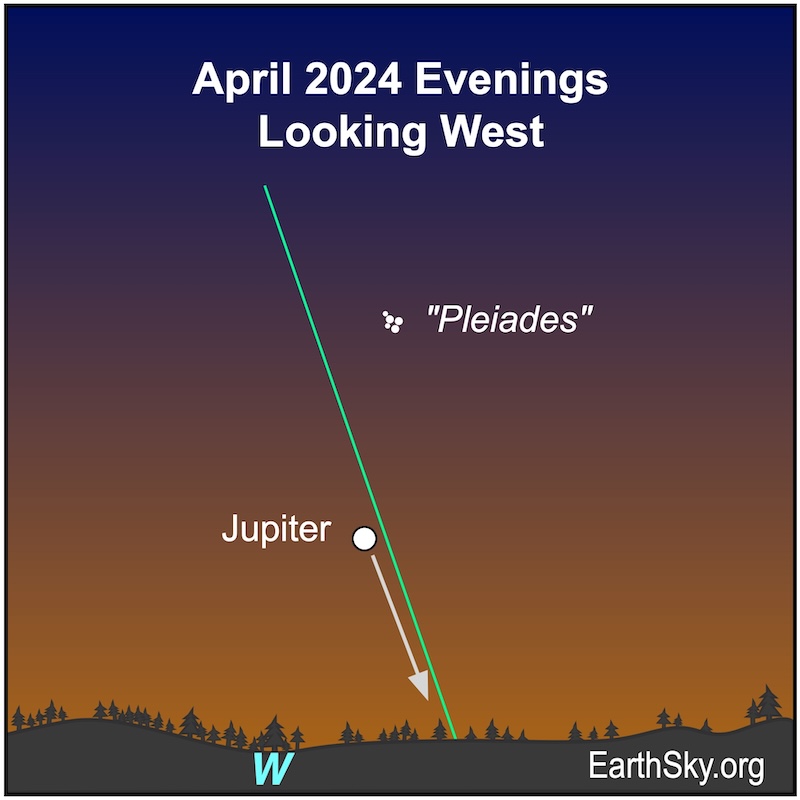
April 23: Full moon near Spica
The full moon will glow brightly near the bright star Spica in Virgo the Maiden. Full moon occurs at 23:49 UTC (6:49 p.m. CDT) on April 23, 2024. It’ll be visible all night.
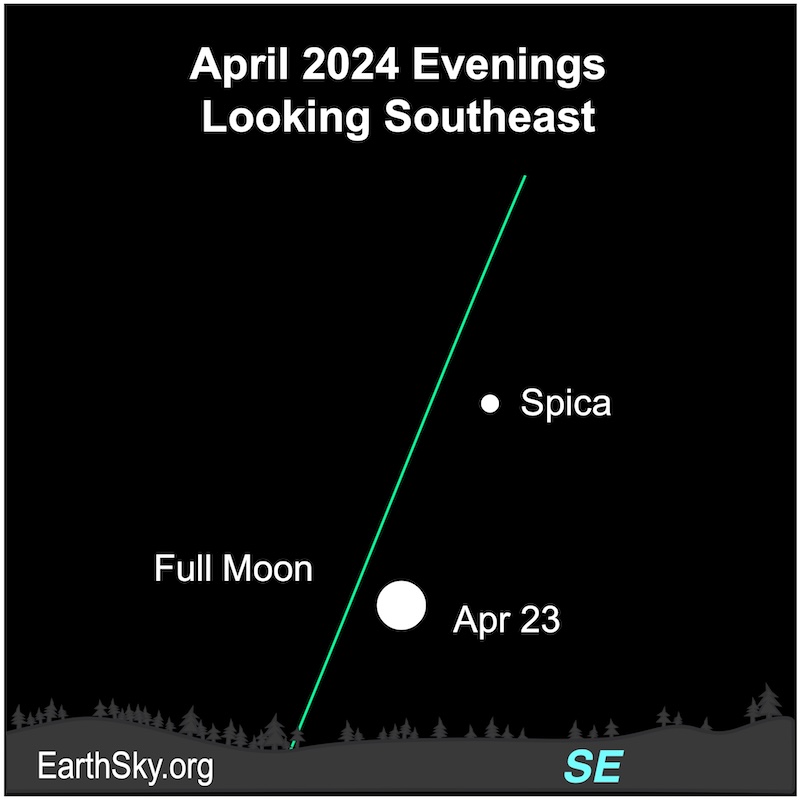
Our charts are mostly set for the northern half of Earth. To see a precise view – and time – from your location, try Stellarium Online.
April 26 and 27 mornings: Moon near Antares
On the mornings of April 26 and 27, 2024, the waning gibbous moon will lie close to the bright star Antares in Scorpius the Scorpion. They’ll be visible from early morning until dawn. Also, skywatchers in Asia and Africa will see the moon pass in front of – or occult – Antares near 21 UTC on April 26.
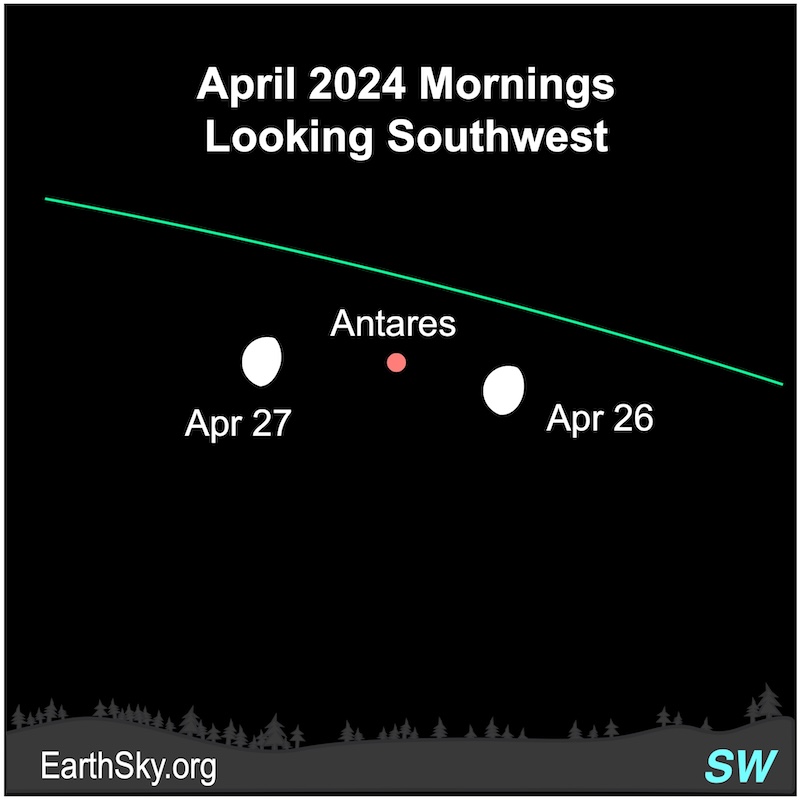
The Big Dipper and Leo the Lion
April is a great time to look up overhead in the evening sky and find the well-known pattern of stars we call the Big Dipper. It’s an asterism – or obvious pattern of stars – and part of the constellation Ursa Major the Great Bear. Also, you can find the constellation Leo the Lion. Leo has another well-known asterism known as the Sickle. The Sickle looks like a backward question mark that is punctuated by the bright star Regulus. In fact, the Big Dipper can help you locate Leo and the Sickle. An imaginary line drawn southward from the pointer stars in the Big Dipper – the two outer stars in the Dipper’s bowl – points toward Leo the Lion.

The Big Dipper and Polaris
Plus, the Big Dipper can direct you to find Polaris, the North Pole Star. The two outer stars in the bowl of the Dipper point to Polaris. It’s at the end of the handle of Ursa Minor the Little Bear, commonly known as the Little Dipper. Look for the Big and Little Dippers high in the northern sky on spring evenings. This view is for the Northern Hemisphere.
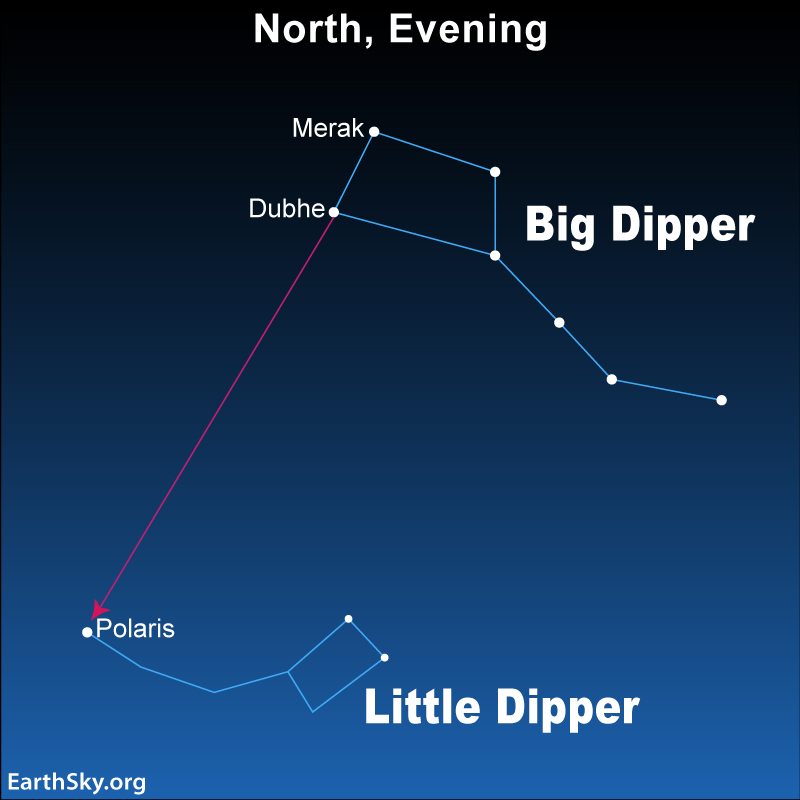
Cancer the Crab
Cancer the Crab, with its Beehive star cluster, needs a dark sky to be seen. It lies between the Gemini twin stars Castor and Pollux, and the bright star Regulus in Leo the Lion.
Once you’ve found Cancer – if your sky is dark – you can see the wonderful open star cluster called the Beehive. It contains some 1,000 stars.

Have fun exploring the sky!
April evenings: Jupiter
Jupiter appears low in the west shortly after sunset in the first three weeks of April. During the month’s final week, it lies too low in the bright evening twilight to be easily seen. At the beginning of the month, Jupiter sets about three hours after sunset. At month’s end, Jupiter lies low in the evening twilight and may be challenging to spot. Jupiter will lie near the delicate Pleiades star cluster.

April mornings: Mars and Saturn
Mars and Saturn lie low in the morning twilight in April 2024. They shine with similar brightness and have a close pairing on the mornings of April 10 and 11. Saturn will climb a bit higher as the month goes on, and Mars will not move as much on the sky’s dome. By month’s end, Saturn will rise about two hours before sunrise and Mars will follow it about an hour later. Both planets will be easier to find in the coming months as they climb out of the morning glare.

Where’s Venus and Mercury?
Venus is too close to the sun to be visible this month, and it’ll emerge in the evening sky around the beginning of August. Mercury will disappear from the bright evening twilight at the beginning of April and return to the morning sky in May.
Thank you to all who submit images to EarthSky Community Photos! View community photos here. We love you all. Submit your photo here.
Looking for a dark sky? Check out EarthSky’s Best Places to Stargaze.
Sky dome maps for visible planets and night sky
The sky dome maps come from master astronomy chart-maker Guy Ottewell. You’ll find charts like these for every month of 2024 in his Astronomical Calendar.
Guy Ottewell explains sky dome maps

Heliocentric solar system visible planets and more
The sun-centered charts come from Guy Ottewell. You’ll find charts like these for every month of 2024 in his Astronomical Calendar.
Guy Ottewell explains heliocentric charts.

Some resources to enjoy
For more videos of great night sky events, visit EarthSky’s YouTube page.
Watch EarthSky’s video about Two Great Solar Eclipses Coming Up
Don’t miss anything. Subscribe to daily emails from EarthSky. It’s free!
Visit EarthSky’s Best Places to Stargaze to find a dark-sky location near you.
Post your own night sky photos at EarthSky Community Photos.
Translate Universal Time (UTC) to your time.
See the indispensable Observer’s Handbook, from the Royal Astronomical Society of Canada.
Visit Stellarium-Web.org for precise views from your location.
Almanac: Bright visible planets (rise and set times for your location).
Visit TheSkyLive for precise views from your location.
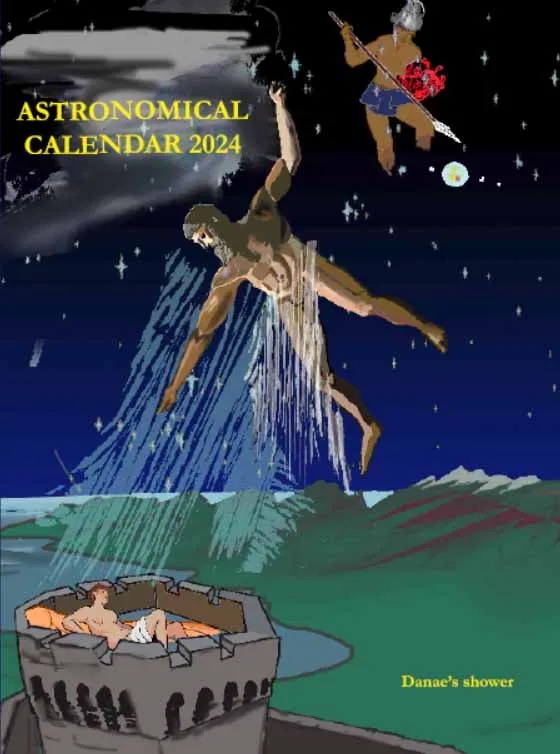
Bottom line: Visible planets and star guide for April 2024. Want to know more about moon phases for the month of April? Join EarthSky’s Marcy Curran for a 1-minute video preview.











